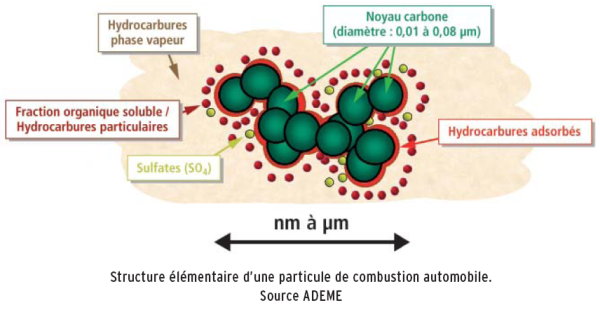Automobile combustion particles and their elimination devices. ADEME document
Results of the program carried out by ADEME since 1995 "Automotive particles".
Physicochemical characterization of particles. Effectiveness of the depollution devices.
Introduction
Despite significant progress in limiting pollutant discharges from cars, due to regulations and technological advances, there remains a concern about the emission of certain pollutants, such as nitrogen oxides and particulates, due to the constant increase in passenger and goods traffic.
In fact, Diesel, initially used almost exclusively for heavy vehicles, has seen its use develop very strongly for private vehicles in recent years. To date, it represents 60% of sales and nearly 50% of the passenger vehicle fleet in France. This success is linked to the economic nature of the use of these engines (low diesel price associated with a lower volume consumption than that of gasoline engines) and to the technological progress from which they have benefited in recent years.
The recent solutions implemented (high pressure direct injection, variable geometry turbocharger) have undoubtedly made it possible to increase the performance of these engines, while further reducing their intrinsic fuel consumption, pollutant emissions, as well as their noise emissions.
From an environmental point of view, the diesel engine is however penalized by the particle emissions it causes.
The study and treatment of these solid compounds, visible in the exhaust and strongly criticized for their impact on air quality, is the subject of numerous characterization and development work. The particles emitted are found suspended in the air and can be inhaled and settle in a point in the respiratory tract or be exhaled. The site of deposition, or the probability of expiration, depends on the properties of the particles, the respiratory tract, and the respiratory regime. Short-term health effects appear at relatively low concentrations (less than 50 μg / m3) and are verified at the medical level (consultations, emergency room admissions).
For higher concentrations, it is established a correlation between the presence of particles and the appearance of chronic bronchitis.
As regards the longer-term effects (cardiovascular effects, cancers of the respiratory tract), numerous expertises have been carried out by public health organizations in industrialized countries (IARC, 1989; INERIS, 1993; HEI (Health Effects Institute ), 1995; French Society of Public Health (SFSP), 1996…).
To date, the mutagenicity of these combustion residues has been experimentally proven.
But the carcinogenic effects of such fumes could only be demonstrated for certain animal species and for pollutant concentrations much higher than those encountered in the environment. In humans, epidemiological studies in the workplace tend to show an increased incidence of lung and bladder carcinomas.
In addition, studies conducted in the United States tend to demonstrate an increased risk of lung cancer, associated with long-term exposure to particulate pollution in ambient air. Diesel particles have been classified as probable carcinogens by the International Agency for Research Against Cancer.
The growing interest in diesel engines, both for goods transport vehicles and for passenger cars, and the health impacts highlighted, prompt us to ask a number of important questions, in particular that of the relevance of emissions regulations.
In view of the fact that it is the finest particles that penetrate deep into the respiratory tract and that their harmfulness also depends on their chemical composition, the two questions that need to be answered are:
- Won't the technical devices envisaged to deal with the tightening of emission standards have a more effective action on large, heavier particles than on finer particles, thus calling into question the relevance of the current regulations? which relates to the mass of the particles emitted?
- What is the chemical composition of the particles emitted, are their dangerous compounds correctly eliminated by technical devices?
To answer these questions, ADEME decided, in 1990, to quantify the performance of a particulate filter (DPF).
At that time, the first application concerned a bus to take into account the quantities emitted in urban areas. However, the technology is not mature, the results were not satisfactory.
ADEME then decided to structure a major characterization program, articulated around two major axes:
- A research program focused on the physico-chemical characterization of particles of automobile origin. The objectives of this program, launched in 1995 as part of the PRIMEQUAL / PREDIT program, aim on the one hand to inform the mechanisms of formation of these particles.
and on the other hand to identify the characteristics of soot responsible for effects on health. This part is developed in the first part of the document.
- A performance evaluation program, in use on fleets, of the first available systems. The evaluations concerned all road vehicles, buses, household refuse collection vehicles, heavy goods vehicles, light vehicles. For each type of vehicle concerned, all the relevant systems are evaluated, both in actual use (durability and efficiency) and in the laboratory, for precise and comparable data. This component is the subject of the second part of the document.
More:
- Fine particles, health impact
- PhD thesis on particles
- Discussion on the effectiveness of particulate filters?


